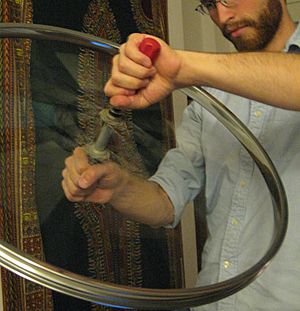Twirling facts for kids
Twirling is a cool way to move an object around using your hands, fingers, or even other parts of your body! When you twirl, you make the object go in circles or almost circles. Sometimes, you can even twirl things indirectly, like using special sticks to move a "devil stick." People twirl for fun, as a sport, for exercise, or even as a performance.
Contents
Different Kinds of Twirling
There are many types of twirling, and each one uses different equipment or "props." All these props are usually shaped like a stick or something similar, and they spin around during the activity. Let's look at some of them!
Astrowheeling
Astrowheeling is a type of twirling that uses a heavy spinning wheel with handles. It mixes the cool look of twirling with the challenge of spinning a heavy object. This helps you get better at balance, focus, and control. This activity was inspired by old practices where people used spinning objects to improve themselves. The modern way of astrowheeling, using wheels like bike wheels, became popular in North America in the 1980s.
Baton Twirling
Baton twirling is a sport that has grown a lot. It's now similar to rhythmic gymnastics. This sport is popular in many countries, including the United States, Japan, Spain, and Canada. Many countries even compete each year at the World Baton Twirling Championships!
Baton twirling is a fairly new sport. It has changed a lot over time. Here are some key things about it:
- You handle the baton to create cool shapes and patterns. You do this with skill, smoothness, and speed. You can keep the baton close to your body or throw it high in the air.
- You use dance and movement to show strength, flexibility, and grace. This is all done while you are moving the baton.
- Gymnastic moves are added to make the routine more exciting.
This sport needs you to combine all these things at the same time, set to music. It's all about showing off your technical skills and artistic expression. Baton twirling is fun to watch! It takes a lot of precise timing and focus. It also requires you to be in top physical shape.
Baton twirling combines the strength and quickness of gymnastics and dance. It also has the beauty of figure skating and ballet. Plus, it needs the technical skill of all these sports put together.
Competitions
Routines for competitive baton twirling are made for athletes of all levels. This includes beginners to advanced twirlers. In individual events, athletes use one, two, or three batons. They perform to standard music. Group events involve many twirlers working together with great precision. There are also pair and team events, like Freestyle Pairs and Freestyle Team, which are for the highest levels. Groups use their own pre-recorded music.
Expert judges from the World Baton Twirling Federation (WBTF) score the competitions. One of the biggest awards in twirling is winning a "WBTF Gold Medalist" title.
History of Baton Twirling
Baton twirling started in Eastern Europe and Asia. People think it began at dance festivals. There, people would twirl knives, guns, torches, and sticks. Later, this activity moved into armies. Soldiers would twirl rifles during marches. When an army paraded, a rifle twirler would lead the marchers.
The rifle was then changed to a "mace." A mace was much bigger and heavier than today's batons. Some marching bands still use maces in parades now. The person carrying the mace, called a "drum major," would twirl it while leading the army or band. This became very popular in the United States after World War II.
Maces were later changed to be easier to twirl. They now look like the batons we see today. They have smaller, light rubber ends and are made of hollow metal. They are also balanced for better accuracy. It's thought that when women, called "drum majorettes," started twirling, the baton became lighter and more balanced. The sport came to North America when Major Millsap started Millsap's College in Mississippi after the Civil War.
Many countries have their own national twirling groups. However, the World Baton Twirling Federation (WBTF) guides the sport of baton twirling around the world.
Pen Spinning
Pen spinning is when you use your fingers to move a regular pen around. You can do it almost anywhere! Sometimes, it's seen as a type of contact juggling. Pen spinning can also include throwing and catching the pen.
In Japan, where it's popular among students, it's called "rōnin mawashi". Just like other skills, pen twirling has its stars. Famous masters of this art are known for creating their own special "moves." For example, David Weis is known for many "back" style moves, like the "BackAround". Hideaki Kondoh is often given credit for naming the pen trick "Sonic", because of how fast the pen would blur in his fingers.
Pen spinning has become much more recognized recently. This is thanks to websites like YouTube. Since 2006, pen spinning has grown into subcultures in many countries. This includes parts of Asia and Europe, like France, Germany, and Poland.
Poi
Poi is a type of juggling, dance, or performance art. It uses balls or other weights attached to ropes or chains. You hold one in each hand and swing them in different circular patterns. It's a bit like twirling clubs. The Māori people of New Zealand first practiced poi. The word poi means "ball" in their language.
Rhythmic Gymnastics
Rhythmic Gymnastics combines parts of ballet, gymnastics, and dance with using special equipment. It used to be mostly for women and girls, but it's becoming more popular with men too. The Japanese version of Men's rhythmic gymnastics includes tumbling. It is performed on a spring floor. Men compete with four types of equipment: rope, stick, double rings, and clubs. Groups of men do not use any equipment. Japan hosted the first men's world championships in 2003.
Rhythmic gymnastics as a sport began in the 1940s in the former Soviet Union. This is where the energy of sports was first mixed with the beautiful art of classical ballet.
In 1961, it was called 'modern gymnastics'. Later, it became 'rhythmic sportive gymnastics'. The first World Championships for individual gymnasts happened in 1963 in Budapest.
Today, rhythmic gymnastics continues as a sport. Also, people who do it as a hobby use the props. These include the women's Ball, Clubs, Hoop, Ribbon, and Rope. They also use the stick and rings from men's gymnastics. These props are used for exercise and fun. They have become popular in the modern juggling and dexterity play community. People use them to do tricks and moves for fitness and flexibility.
Sticks and Staves
Devil Sticks
"Twirling," "sticking," and "stick juggling" are all common names for using props called devil sticks or flower sticks. A set of devil sticks has one main baton and two control sticks.
To use them, you push, lift, and guide the central baton with the two control sticks. This makes the baton flip, wobble, spin, and fly through different moves or tricks.
Juggling sticks, similar to the ones today, have changed over many centuries. They seem to have started in Africa before 3000 BCE. "Devil sticks" might have traveled along the Silk Road, from Cairo to China. They have been used in Europe since the Renaissance.
Morris Dancing
In some types of Morris dancing, dancers twirl a stick in one hand while they dance. For example, in stick dances from Brackley, England, each dancer twirls one or two sticks throughout the dance.
Staff Twirling
Staff twirling is the art or sport of skillfully moving a long staff. This can be a quarterstaff, bo, or other long piece of wood, metal, or plastic. People do it for fun, as a sport, or as a performance.
In the martial art of bojutsu, a bo is used as a weapon. It helps to make a strike stronger. Bojutsu kata are detailed patterns of movements. They are practiced to make your form perfect. These kata are also used in many traditional Japanese arts, like kabuki. Some of these kata are very smooth and nice to watch or to perform.
Staff twirling has become more popular recently. This is thanks to the dexterity play, juggling, and fire dancing communities. This growth is partly because of martial arts. It's also because adult play is becoming more popular as a hobby.
|





